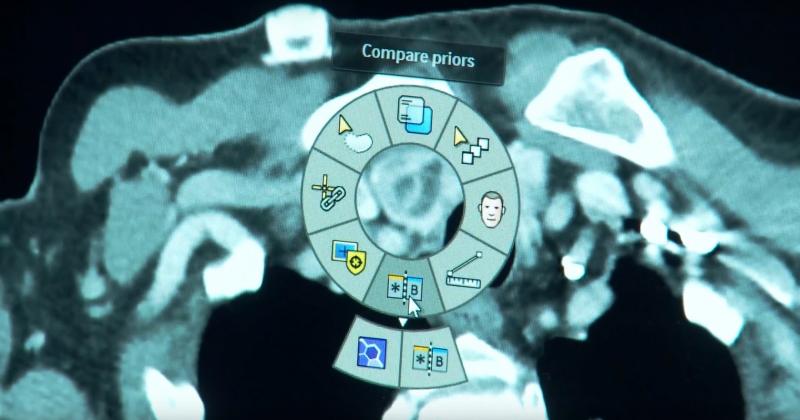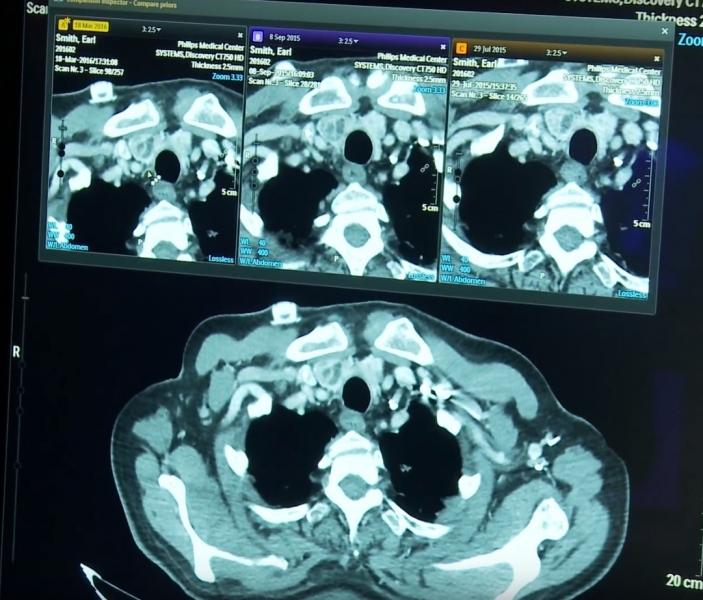
Greg Freiherr has reported on developments in radiology since 1983. He runs the consulting service, The Freiherr Group.
How People And Technology Work Together

Philips’ Illumeo supports the comparison of current and prior patient images. (Screen shots are from the ITN video “How Artificial Intelligence Is Changing Radiology.”)
Patients benefit when providers and technology work together. That may be especially so with the arrival of artificial intelligence (AI). The question is how to mesh the latest technologies optimally with human expertise in the field.
Leveraging AI through adaptive intelligence, Philips’ Illumeo performs time-consuming and tedious tasks otherwise performed by physicians and staff. These types of tasks – pulling together clinical data and images, for example, and bringing up software for physicians to interpret images – lengthen the diagnostic process, potentially increasing health care costs, and adding to the risk of error.
Illumeo exemplifies the company’s interest in developing technology that helps physicians and staff deliver care less expensively and more efficiently.
“Working together with technology, we can solve problems – but those solutions have to be addressed as an integration of people and technology,” said Kees Wesdorp, business group leader of Diagnostic Imaging at Philips.
Developing Meaningful Innovation
More than a decade ago, this thinking led the company to develop SmartExam* software, which helps plan MR scans based on patient anatomy it automatically recognizes. Since its introduction at RSNA 2005, SmartExam* has been optimized for MR of the brain, breast, spine, shoulder and knee. The tool supports technologists in making scans reproducible and efficient. This can shorten exams, which can reduce cost and improve patient comfort.
Reflective of Philips’ latest efforts at meaningful innovation, Illumeo leverages “contextually aware” technologies to provide radiologists, staff and referring physicians with the information they need, when they need it. “Illumeo delivers information from different sources to give a comprehensive overview of the patient even before the case is read, and optimizes tools and views based on deep understanding of patient context,” said Kevin Lev, Illumeo marketing lead at Philips. “This holistic view facilitates a more confident and quantitative diagnosis and could augment value-based care.”
Recognizing the on-screen context of a CT image, the software might pull recent lab results for that patient from the electronic medical record, as well as prior images from the PACS. Or, like a surgical nurse who knows the instrument the surgeon will need next, Illumeo might call up tools the radiologist will need to compare and analyze prior and current images. (A video titled “How Artificial Intelligence Is Changing Radiology” demonstrates Illumeo’s capabilities.)
Similarly, PerformanceBridge helps the radiology administrator with data analytics for continuous performance improvement to enable better operational efficiency and effectiveness. Analytical tools backed by Philips professionals collect and assess data across disparate systems to help radiology administrators and executives make the best use of assets and people. It provides near real-time dashboards that illustrate with line, bar and pie charts. It also issues alerts about how different machines are being utilized. Complementing the technology, Philips’ Solution Advisors work directly with customers to help deploy processes and systems to improve performance.
PerformanceBridge, said Sham Sokka, Philips general manager of Radiology Solutions, “is a command and control system that drives continuous improvement, as it informs and guides department strategy.”
The value of PerformanceBridge was seen firsthand when Philips – via its PerformanceBridge Practice Assessment – evaluated two outpatient sites in Einstein Healthcare Network in Pennsylvania. The two were evaluated for the economic benefit that might come from installing a new MR scanner. Neither site had the modality. But because they offered X-ray, ultrasound, CT or mammography, Philips was able to analyze referral patterns for these modalities and reimbursement information about the patients, uncovering patterns applicable to MRI.
“It was a very robust and thorough evaluation from a business perspective,” said Terence A.S. Matalon, M.D., chairman of diagnostic radiology at the network. “The information was above and beyond what we had considered in terms of where we could site this magnet.”
Key Ingredient
When automation improves the performance of staff and physicians, everyone benefits – especially patients. The key ingredient in this equation is people.
Regardless of the particular solution, the underlying goal is the same – to improve staff efficiency, diagnostic confidence and the delivery of patient-centered care. All three depend on supporting the people at the heart of imaging. This is the foundation of Philips’ long-term imaging partnerships.
“People I have dealt with over the years from Philips have been very solid, honest and interested in not just their own but the customer’s success,” said Christopher Wald, M.D., radiology chair at Lahey Hospital and Medical Center in Burlington, Mass.
“The longtime partnership with Lahey Hospital and Medical Center has helped Philips understand “what the actual customer needs,” Wald said. This understanding has come from Philips’ staff observing physicians and staff in their day-to-day work.
“There’s tremendous power in observation,” he said. “The ability to come in here, into the context [of health care] and just watch and then ask questions is extremely powerful.”
For more information about Philips Radiology Solutions, visit www.philips.com/radiology
Author’s note: This is the third blog in the series Making Innovation Meaningful. Read the first blog, How Playing the Long Game Works for Philips and its Customers, and the second blog, How to Create Meaningful Innovations in Imaging.
* SmartExam is not available to patients with MR Conditional Implants.



 April 22, 2024
April 22, 2024 








